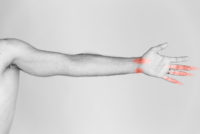
Trigger points in the adductor pollicis and opponens pollicis muscles cause aching pain in your thumb, the base of the thumb, and the thumb side of your wrist. Spillover pain may include most of the thumb, webbing, and the fleshy mound at the base of the thumb on the palm.
Your thumb may also feel clumsy. Handwriting, sewing, painting, and buttoning clothes may be difficult.
The pain from adductor pollicis and opponens pollicis trigger points can be easily avoided by reducing stress at your thumb, stretching, and relaxing the muscles of your hand and forearm.
Avoid the use of the strong pincer grip (adduction and opposition) and twisting motions characteristic of weeding by hand, writing with a ballpoint pen, and other fine handwork. Any movements that require strong adduction or opposition of your thumb present a stress overload. Take a break from extended sessions at these activities and perform stretches and relax your hand as often as possible.
Any movements that require strong adduction or opposition of your thumb present a stress overload. Take a break from extended sessions at these activities and perform stretches and relax your hand as often as possible.
You can use pressure self-release for the thumb grip muscles while seated. Using your hand from the unaffected side, begin by using your thumb to gently massage the base of your other thumb. Explore the muscles, note areas that are sorer, and bring your focus to them.
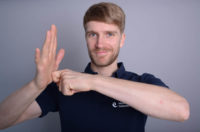
The most pinpoint pressure and accuracy comes from using the knuckle of your index finger. Try opposing and repositioning your thumb as you compress these areas.
Trigger points in the flexors can be easily prevented by moderating gripping activities, stretching, and relaxing the muscles of the forearm.
 After completing self-compressions, move your wrist and fingers through their range of motion and prepare to gently stretch your thumbs. Begin by shaking out your hands and fingers in a “finger flutter” exercise and do a few wrist circles. Continue with the stretches that target your thumbs.
After completing self-compressions, move your wrist and fingers through their range of motion and prepare to gently stretch your thumbs. Begin by shaking out your hands and fingers in a “finger flutter” exercise and do a few wrist circles. Continue with the stretches that target your thumbs.
 The adductor and opponens pollicis muscle can develop trigger point activations from any activity that requires forceful closing and gripping with your thumb. Healed fractures of your hand may also leave you with residual trigger points. The fracture normally heals pain-free; residual pain is usually myofascial.
The adductor and opponens pollicis muscle can develop trigger point activations from any activity that requires forceful closing and gripping with your thumb. Healed fractures of your hand may also leave you with residual trigger points. The fracture normally heals pain-free; residual pain is usually myofascial.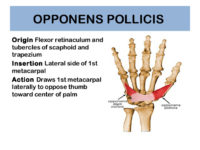
The apposition of the thumb is the combination of adduction and opposition from adductor pollicis and the opponens pollicis that allows the tip of the thumb to touch the tips of other fingers.
Opponens Pollicis originates in the wrist and is inserted into the whole length of the metacarpal bone of the thumb on its radial side.
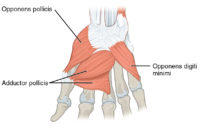 Adductor Pollicis – The oblique head arises in the wrist and base of the 2nd and 3rd fingers. It converges with a tendon that is inserted into the pinky side of the base of the first segment of the thumb. A considerable bundle of fibers also passes more at an angle to join the lateral portion of the flexor pollicis brevis and the abductor pollicis brevis. The transverse head is deeply seated and triangular, arising by a broad base from the lower two-thirds of the palmar surface of the third finger; the fibers converge, to be inserted into the base of the thumb.
Adductor Pollicis – The oblique head arises in the wrist and base of the 2nd and 3rd fingers. It converges with a tendon that is inserted into the pinky side of the base of the first segment of the thumb. A considerable bundle of fibers also passes more at an angle to join the lateral portion of the flexor pollicis brevis and the abductor pollicis brevis. The transverse head is deeply seated and triangular, arising by a broad base from the lower two-thirds of the palmar surface of the third finger; the fibers converge, to be inserted into the base of the thumb.
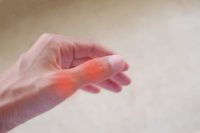 Trigger points in the adductor pollicis muscle causes aching pain along the outside of the thumb and base of thumb up to the crease of the wrist. Spillover pain may include most of the thumb, webbing and the fleshy mound at the base of the thumb on the palm.
Trigger points in the adductor pollicis muscle causes aching pain along the outside of the thumb and base of thumb up to the crease of the wrist. Spillover pain may include most of the thumb, webbing and the fleshy mound at the base of the thumb on the palm.
Pain from opponens pollicis trigger points refers to most of the thumb and an area on the thumb side of the wrist.
Your thumb may also feel clumsy. Handwriting, sewing, painting, and buttoning clothes may be difficult.
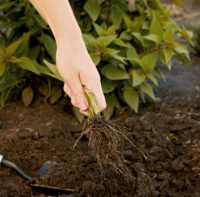 The pain from adductor pollicis and opponens pollicis trigger points can be easily avoided by reducing stress at your thumb, stretching, and relaxing the muscles of your hand and forearm.
The pain from adductor pollicis and opponens pollicis trigger points can be easily avoided by reducing stress at your thumb, stretching, and relaxing the muscles of your hand and forearm.
Avoid the use of the strong pincer grip and twisting motions characteristic of weeding by hand. To continue gardening, use a small trowel, spade, or other assistive tools to break up the dirt first.
Avoid hand-writing with a ballpoint pen – type or use a felt-tip pen, which requires much less pressure. If using a pen for handwriting, take care to reduce the pressure of your pen.
Avoid fine handwork such as painting, needlepoint, or assembling small electronic components.
Any movements that require strong adduction or opposition of your thumb present a stress overload.
Take a break from extended sessions at these activities and perform stretches and relax your hand as often as possible.
Myofascial self-care always starts with establishing a foundation of diaphragmatic breathing. Once you have taken a few moments to get in touch with your breath, we move on to self-compression and stretching. You may find that a warm bath or shower, or applying moist heat before you begin is helpful.

You can use pressure self-release for the thumb grip muscles while seated. It helps your forearm relax if it is well supported by a pillow or other padded armrest.
Using your hand from the unaffected side, begin by using your thumb to gently massage the base of your other thumb. Explore the muscles, note areas that are sorer, and bring your focus to them.

The most pinpoint pressure and accuracy comes from using the knuckle of your index finger. Make a loose fist with the remaining fingers, extend the knuckle of your index finger and support it with your thumb.
Find the tender spot and apply pressure for up to 30 seconds as pain decreases. You can do this three to five times.
 Try opposing and repositioning your thumb as you compress these areas.
Try opposing and repositioning your thumb as you compress these areas.
Many blood vessels and nerves in the arm are superficial, so pressure self-release should be done with caution. If you feel tingling or circulation changes in your hand you should reposition and take a different approach.
After completing self-compressions, move your wrist and fingers through their range of motion and prepare to gently stretch your thumbs. Begin by shaking out your hands and fingers in a “finger flutter” exercise and do a few wrist circles. Continue with the stretches below:
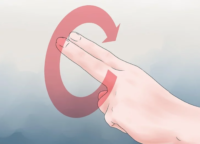
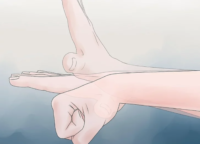
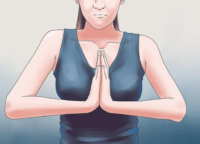

You can use your breath to deepen the stretches shown.
If you experience pain following pressure release and stretching, a cold pack may be helpful.
The 40-minute video below discusses the treatment of hand and finger pain from a physical therapy perspective, including the use of a hand massage called the iPalm:
If you maintain a posture or activity that activates a trigger point in any muscle it will continue.
 The adductor and opponens pollicis muscle can develop trigger point activations from any activity that requires forceful closing and gripping with your thumb.
The adductor and opponens pollicis muscle can develop trigger point activations from any activity that requires forceful closing and gripping with your thumb.
When pulling weeds, the combined effects of flexion, twisting, pulling can cause trigger points in the adductor and opponens pollicis, leading to pain in the thumb and base of the thumb. Healed fractures of your hand may leave you with residual trigger points. The fracture normally heals pain-free; residual pain is usually myofascial.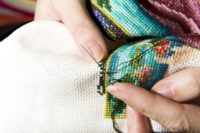
Other activities that can re-activate adductor and opponens pollicis trigger points include: sewing, needlepoint, handwriting, and painting.
 Opposition of the thumb is a combination of actions that allows the tip of the thumb to touch the tips of other fingers.
Opposition of the thumb is a combination of actions that allows the tip of the thumb to touch the tips of other fingers.
The part of apposition that this muscle is responsible for is the flexion of the thumb’s metacarpal at the first carpometacarpal joint. This specific action cups the palm.
In order to truly appose the thumb, the actions of a number of other muscles are needed at the thumb’s metacarpophalangeal joint. Note that the two opponens muscles (opponens pollicis and opponens digiti minimi) are named so because they oppose each other, but their actions appose the bones.
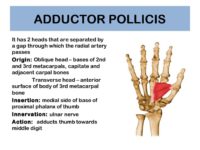 While adduction of the thumb (bringing it back into the plane of the palm of the hand from its previously abducted position) is mainly produced by the adductor pollicis, it can also bring the thumb to the side of the palm and index finger and the flexor pollicis brevis and the opponens pollicis help in thumb adduction.
While adduction of the thumb (bringing it back into the plane of the palm of the hand from its previously abducted position) is mainly produced by the adductor pollicis, it can also bring the thumb to the side of the palm and index finger and the flexor pollicis brevis and the opponens pollicis help in thumb adduction.

The movements of gripping the thumb include pulling it towards the index finger (adductor) and crossing the palm (opponens).
Opponens Pollicis originates from the flexor retinaculum of the hand and the tubercle of the trapezium. It passes downward and laterally and is inserted into the whole length of the metacarpal bone of the thumb on its radial side.
Adductor Pollicis
Oblique head
The oblique head arises by several slips from the capitate bone of the wrist, the bases of the second and third metacarpals, the intercarpal ligaments, and the sheath of the tendon of the flexor carpi radialis.
From this origin, most fibers pass obliquely downward and converge to a tendon that unites with the tendons of the medial portion of the flexor pollicis brevis and the transverse head of the adductor pollicis, and is inserted into the ulnar side of the base of the first segment of the thumb, with a sesamoid bone in the tendon.
A considerable bundle of fibers, however, passes more obliquely beneath the tendon of the flexor pollicis longus to join the lateral portion of the flexor pollicis brevis and the abductor pollicis brevis.
Transverse head
The transverse head is deeply seated.
It is triangular, arising by a broad base from the lower two-thirds of the palmar surface of the third metacarpal bone; the fibers converge, to be inserted with the medial part of the flexor pollicis brevis and the oblique head into the ulnar side of the base of the first segment of the thumb.
